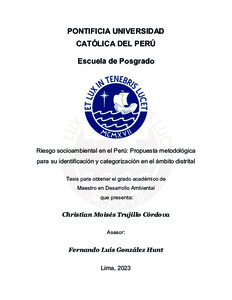| dc.contributor.advisor | González Hunt, Fernando Luís | |
| dc.contributor.author | Trujillo Córdova, Christian Moisés | |
| dc.date.accessioned | 2023-09-11T20:23:30Z | |
| dc.date.available | 2023-09-11T20:23:30Z | |
| dc.date.created | 2023 | |
| dc.date.issued | 2023-09-11 | |
| dc.identifier.uri | http://hdl.handle.net/20.500.12404/25934 | |
| dc.description.abstract | Producto del cambio climático, el Perú ha emprendido un proceso denominado
transición medioambiental. Ello exige a los órganos competentes inspeccionar su
estado periódicamente y, en paralelo, construir propuestas metodológicas
pertinentes para medirlo. Consciente de este reto aún pendiente, la presente
investigación se centra en identificar y categorizar el riesgo socioambiental de los
distritos registrados hasta el 2019 (1874). Para ello, se propone hipotéticamente que
las nuevas zonas con riesgo socioambiental (NZRS) muestran características
sociales y ambientales similares a aquellos municipios con riesgo socioambiental
previamente identificados, en total, 93 por medio de juicio de expertos. En este
análisis, se trabaja desde el enfoque de sociedad del riesgo de Beck (1999) y
desarrollo sostenible de las Naciones Unidas. Metodológicamente, se utiliza
principios de la teoría de la complejidad social y el aprendizaje automatizado para
localizar las NZRS. Poniendo en acción un enfoque cuantitativo y multietápico con
tres fases (teorización, caracterización y modelación), se construyó 8 modelos;
siendo sus resultados probabilísticos insumos para la elaboración de un índice
social, ambiental y general (el índice de riesgo socioambiental). Posteriormente,
este procedimiento permite establecer 4 niveles del riesgo (Alto, medio alto, medio
bajo y bajo). Finalmente, de acuerdo a los resultados obtenidos, se corrobora la
hipótesis planteada inicialmente. En tal sentido, es posible concluir que el modelo
de desarrollo urbano en el Perú actualmente no es coherente con los esfuerzos de
conservación y preservación del medio ambiente. | es_ES |
| dc.description.abstract | Product of climate change, Peru has undertaken a process called environmental
transition. This requires the competent bodies to inspect its status periodically and,
in parallel, build pertinent methodological proposals to measure it. Aware of this
pending challenge, this research focuses on identifying and categorizing the socioenvironmental risk of the districts registered until 2019 (1874). For this, it is
hypothetically proposed that the new zones with socio-environmental risk (NZSR)
show social and environmental characteristics similar to those previously identified
municipalities with socio-environmental risk, a total of 93 through expert judgment.
In this analysis, we work from the risk society approach of Beck (1999) and
sustainable development of the United Nations. Methodologically, principles of social
complexity theory and machine learning are used to locate the NZSR. Putting into
action a quantitative and multistage approach with three phases (theorization,
characterization and modeling), 8 models are built; its probabilistic results being
inputs for the elaboration of a social, environmental and general index (the socioenvironmental risk index). Subsequently, this procedure makes it possible to
establish 4 risk levels (High, medium high, medium low and low). Finally, according
to the results obtained, the hypothesis initially raised is corroborated. In this sense,
it is possible to conclude that the urban development model in Peru is currently not
coherent with the efforts of conservation and preservation of the environment. | es_ES |
| dc.language.iso | spa | es_ES |
| dc.publisher | Pontificia Universidad Católica del Perú | es_ES |
| dc.rights | info:eu-repo/semantics/openAccess | es_ES |
| dc.rights | Atribución-NoComercial-CompartirIgual 2.5 Perú | * |
| dc.rights.uri | http://creativecommons.org/licenses/by-nc-sa/2.5/pe/ | * |
| dc.subject | Transición ecológica--Perú | es_ES |
| dc.subject | Política ambiental--Perú | es_ES |
| dc.subject | Riesgo ambiental--Perú | es_ES |
| dc.subject | Desarrollo sostenible--Perú | es_ES |
| dc.title | Riesgo socioambiental en el Perú: Propuesta metodológica para su identificación y categorización en el ámbito distrital | es_ES |
| dc.type | info:eu-repo/semantics/masterThesis | es_ES |
| thesis.degree.name | Maestro en Desarrollo Ambiental | es_ES |
| thesis.degree.level | Maestría | es_ES |
| thesis.degree.grantor | Pontificia Universidad Católica del Perú. Escuela de Posgrado | es_ES |
| thesis.degree.discipline | Desarrollo Ambiental | es_ES |
| renati.advisor.dni | 07780096 | |
| renati.advisor.orcid | https://orcid.org/0000-0003-1821-6064 | es_ES |
| renati.author.dni | 46134058 | |
| renati.discipline | 521547 | es_ES |
| renati.juror | Bedoya Garland, Eduardo | es_ES |
| renati.juror | González Hunt, Fernando Luís | es_ES |
| renati.juror | Verna Coronado, Vito Leonardo | es_ES |
| renati.level | https://purl.org/pe-repo/renati/level#maestro | es_ES |
| renati.type | https://purl.org/pe-repo/renati/type#tesis | es_ES |
| dc.publisher.country | PE | es_ES |
| dc.subject.ocde | https://purl.org/pe-repo/ocde/ford#1.05.08 | es_ES |







